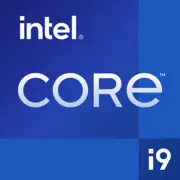Intel Core i9-13900HK

Intel Core i9-13900HK: Raptor Lake Power in a Mobile Format
(March 2025)
Since its release in 2023, Intel's 13th generation Core processors (Raptor Lake) have established themselves as a benchmark for mobile device performance. Among them stands out the flagship laptop chip — Intel Core i9-13900HK, which combines a hybrid architecture, record multi-threading power, and support for modern technologies. Let's explore who this CPU is suitable for and what it is capable of in 2025.
1. Architecture and Process Technology: Hybrid Cores and 24 MB Cache
The processor is built on the Raptor Lake architecture and manufactured using the Intel 7 process (equivalent to 10 nm Enhanced SuperFin). Its key feature is a hybrid structure consisting of two types of cores:
- 6 Performance P-cores with Hyper-Threading support (12 threads);
- 8 Energy-efficient E-cores without multi-threading (8 threads).
In total: 14 cores and 20 threads, which is 2 E-cores more than its predecessor (i9-12900HK). The base frequency is 2.6 GHz, with a maximum turbo frequency of 5.4 GHz for P-cores and 4.1 GHz for E-cores. The L3 cache has been increased to 24 MB (compared to 14 MB in the Ryzen 9 7940HS), speeding up data processing in resource-intensive tasks.
Integrated Intel Iris Xe graphics (96 EUs) supports 4K displays, hardware decoding of AV1, and delivers 60+ FPS in light games (e.g., CS:GO at medium settings). For serious gaming, a discrete graphics card (RTX 4070 and above) is necessary.
2. TDP 45W: Balance Between Power and Heat
The nominal TDP of the processor is 45 W, but in turbo mode, power consumption can reach 115 W (PL2). This requires an efficient cooling system: in compact ultrabooks, the i9-13900HK often operates under restrictions, while in gaming laptops with large coolers, it can fully unleash its potential.
Power-saving technologies:
- Intel Dynamic Tuning — automatically adjusts power depending on workload;
- Adaptix AI — optimizes task distribution between P- and E-cores;
- Energy Saving mode in Windows reduces frequencies to extend battery life.
However, with active use of P-cores (rendering, gaming), even an 80 W·h battery lasts only 2–3 hours.
3. Performance: Leader in Multi-threading, But Not Without Compromises
Geekbench 6 (2025):
- Single-Core: 2579 — comparable to the Ryzen 9 7940HS (2530) and Apple M3 Pro (2600+);
- Multi-Core: 13614 — surpasses most mobile CPUs, except for Ryzen 9 7945HX (16 cores, 14500+).
Real-world scenarios:
- Office tasks (Chrome, Excel, Zoom): CPU rarely goes above 20% load, operating on E-cores and generating minimal heat.
- Video editing (Premiere Pro, 4K H.265): rendering is 30% faster than the i9-12900HK, thanks to the additional E-cores.
- Gaming (Cyberpunk 2077, Ultra, 1440p): with RTX 4080, it achieves a stable 60+ FPS, but the CPU temperature can reach 95°C.
Turbo mode temporarily increases frequencies but causes throttling in thin laptops (e.g., Dell XPS 15). In workstations (MSI Raider), performance remains stable.
4. Use Cases: Who is the i9-13900HK Designed For?
- Professionals: video editors, 3D designers, programmers (code compilation).
- Gamers: streamers playing AAA titles at high settings.
- Enthusiasts: those who value upgrades to DDR5-5600 and PCIe 5.0 (e.g., for 12 GB/s SSDs).
Not recommended for:
- Users who prioritize silence (coolers are loud under load);
- Those who only work with browsers and office applications (i5-13500H is cheaper and cooler).
5. Battery Life: The Cost of Power
During web browsing and working with documents, laptops with the i9-13900HK can last 6–8 hours (e.g., Asus ZenBook Pro 14 with a 76 W·h battery). In gaming or rendering — up to 2 hours.
Tips for extending battery life:
- Activate the Energy Saving mode in Windows;
- Disable turbo mode through utilities (ThrottleStop);
- Choose models with OLED screens, which are more power-efficient than LCDs with dark themes.
6. Comparison with Competitors
- AMD Ryzen 9 7940HS:
- Pros: Better energy efficiency, lower heat.
- Cons: Weaker in single-threaded tasks (by 10–15%), less support for PCIe 5.0.
- Apple M3 Pro (MacBook Pro 16):
- Pros: Battery life up to 18 hours, silent operation.
- Cons: Not suitable for Windows programs and games.
- Intel Core i9-14900HK:
- Pros: 8–12% faster in multi-threaded tasks.
- Cons: Price higher by $200–300.
7. Pros and Cons of i9-13900HK
Strengths:
- Record multi-threaded performance;
- Support for DDR5 and PCIe 5.0;
- Optimization for Windows 11 and DirectX 12 Ultimate.
Weaknesses:
- High heat output under load;
- Dependency on cooling system;
- Laptop prices starting at $2000.
8. How to Choose a Laptop with i9-13900HK?
- Gaming laptop (MSI Raider GE78, $2800): Focus on cooling and discrete graphics.
- Workstation (Lenovo ThinkPad P1 Gen 6, $2500): Certified software for CAD, 4K display.
- Ultrabook (Asus ZenBook Pro 14X, $2200): Compactness but at risk of throttling.
What to look for:
- Number of heat pipes (at least 3);
- TGP of discrete graphics card (at least 140 W for RTX 4070);
- Thunderbolt 4 and HDMI 2.1 ports.
9. Final Conclusion
The Intel Core i9-13900HK is a choice for those willing to sacrifice battery life and noise for maximum performance. In 2025, it remains relevant for:
- Professionals using "heavy" applications;
- Gamers wanting to play in 4K without upgrading their PC;
- Users who value futureproofing with DDR5 and PCIe 5.0.
Alternatives:
- If you need battery life — Apple MacBook Pro 16 (M3 Pro);
- If a balance of price and power is crucial — AMD Ryzen 9 7940HS.
However, for those who prioritize compatibility with Windows and speed in single-threaded tasks, the i9-13900HK remains unparalleled.
Basic
CPU Specifications
Memory Specifications
GPU Specifications
Miscellaneous
Benchmarks
Compared to Other CPU
Related CPU Comparisons
Share in social media
Or Link To Us
<a href="https://cputronic.com/cpu/intel-core-i9-13900hk" target="_blank">Intel Core i9-13900HK</a>
